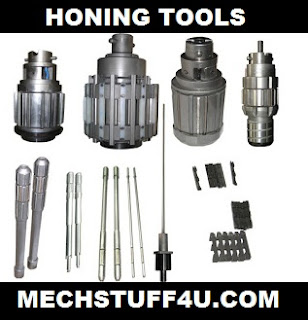Introduction of the Honing Process
The process of honing that produces a good surface on a metal workpiece by scrubbing against it an abrasive stone and specifying the surface finish in the micro finish ranges.
Honing can consistently produce finishes as fine as 4μ inches and ever finer finishes are possible too. It also can remove as little as 0.0001 inches of material or as much as 0.125 inches. However, usually, only 0.002 inches to 0.020 inches of material is left on the diameter of honing. So honing is mainly used to correct some out of roundness, taper, tool marks, and axial distortion.
Honing consists of a tool with three or more abrasive stones that are rotated by controlling pressure and velocity while in contact with the workpiece to obtain precise configuration and finish.
The stones are made of silicon carbide, oxide of aluminium, cubic nitride or diamonds.
Why Honing?
Honing is the cost-effective machining process for removing stock, generating exacting, bore tolerance, bore polishing, finishing bore of almost any material such as-sprayed coating, CGI, ceramics etc.
What is a Honing Operation?
The tool is rotated manually and the workpiece is passed back and over the tool. The tool is given a slow reciprocal motion as it rotates for precision honing. Honing stones can be loosely held in holders, cemented in holders directly, or cast into plastic tabs held in holders.
The honing tool can be made in such a way that a floating action prevails between the tool and the work and any pressure exerted on the tool can be transmitted to all sides equally. Coolants are essential to this process in order to flush away small chips and maintain uniform temperatures.
 |
| Honing tools |
Honing process performed by the tool, including the motion of lifting, turning and feeding. These kinematics give the typical honing angle to this process. The feed movement causes the tool to spread radially, making contact with the bore walls by the abrasive. This is created by an electromechanical feed system, which allows the feed force to be controlled in adjustable limits.
Honing is done as an expedient on general-purpose machines like lathe, drill press, and portable drills but it is possible to obtain more economic results by honing machines for production work.
There are two general types of honing machine one is horizontal and another one is vertical.
The honing process in a wide variety of materials offers advantages of low capital equipment cost, high metal removal rates, and extreme precision of 0.001 mm.
Honing can correct parts that are not square within limits which are used to correct some out of roundness, taper, tool marks and axial distortion.
Advantages of the Honing Process
- Material removal in all materials regardless of hardness.
- Any degree of surface finish in a part.
- The high stock removal rate is up to 12 times faster than internal grinding.
- Low-cost simple fixture
- Due to the lower pressures used in honing and the resulting lower fixing pressures, thin-walled parts are less likely to have distortion.
- The precision produced by honing is independent of the length of the bore.
- Honing maintains the original bore centreline.
- Bores are corrected with the least possible amount of material removal.
Applications of Honing Process
Ideal for finishing the internal surfaces of I.C. engine cylinders, hydraulic cylinders and other cylinders where retention of lubricants film over the surface is important functionally. It is mostly used for finishing automobile crankshaft journals.
Explore more information: